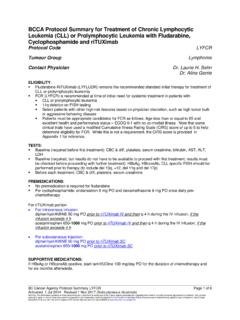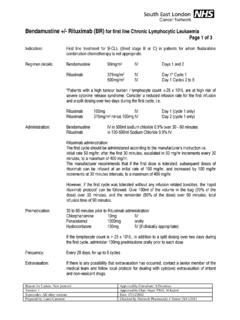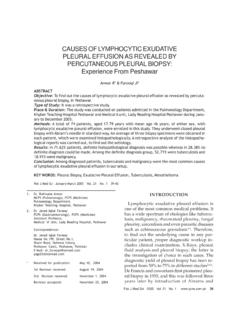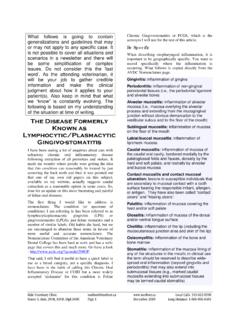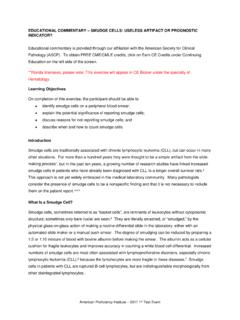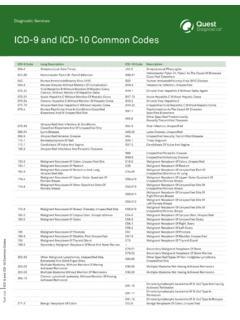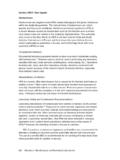Transcription of Patient Diagnosis Resource for LYMPHOCYTIC COLITIS
1 Patient Diagnosis Resource for LYMPHOCYTIC COLITIS . Your Diagnosis After completing a thorough lab analysis of your recent colon biopsy, a specialized doctor called a pathologist reported a Diagnosis of LYMPHOCYTIC COLITIS , an ongoing (chronic) inflammation of the colon. LYMPHOCYTIC COLITIS does not increase the risk of developing colon cancer, and it is not cancer. LYMPHOCYTIC COLITIS is a rare condition that falls under the broad category of inflammatory bowel disease (IBD). It most often affects people between the ages of 50 and 70, and occurs equally in women and men. About the Condition The colon, or large intestine, is a tube lined with muscles that extracts moisture and nutrients from food, storing the waste matter until it is expelled from the body. It is typically 5 to 6 feet long in adults. The last segment of the colon is called the rectum. LYMPHOCYTIC COLITIS occurs when lymphocytes, a type of white blood cell, accumulate between the cells that line the colon and produce inflammation.
2 The condition causes chronic and watery, non-bloody diarrhea and sometimes painful abdominal cramps and nausea. This happens on a continuing basis for some patients and occasionally for others. The inflammation of LYMPHOCYTIC COLITIS is not visible when looking at the surface of the colon during a colonoscopy, but is apparent when colon tissue samples are viewed under a microscope. As a result, it is referred to as a microscopic form of COLITIS . No one knows exactly what causes LYMPHOCYTIC COLITIS , but the condition appears to stem from an overactive immune system response to something that affects the colon lining. Triggers may include an infection with bacteria or a virus, or the prolonged use of non-steroidal anti-inflammatory drugs (NSAIDs) such as ibuprofen and naproxen. Many patients with LYMPHOCYTIC COLITIS have other autoimmune disorders such as rheumatoid arthritis, thyroid disease, pernicious anemia (the inability to absorb vitamin B-12 from the gastrointestinal tract), or celiac disease, a digestive condition caused by intolerance to gluten, a protein found in foods including wheat and rye.
3 LYMPHOCYTIC COLITIS is not life-threatening; however, heavy diarrhea caused by the condition can sometimes lead to severe dehydration, malnutrition and weight loss. Treatment Options The treatment plan for LYMPHOCYTIC COLITIS often depends on the severity of the condition. The following treatment possibilities are available: Everyday Changes Although food is not a direct cause of LYMPHOCYTIC COLITIS , people with the condition can diminish symptoms by eating a low-fat diet that is high in fruits, vegetables and fiber and avoiding caffeine and dairy products. It is also helpful to avoid the use of NSAIDs. Medication A variety of medications can be used to treat LYMPHOCYTIC COLITIS . They include drugs to control diarrhea, anti-inflammatory drugs, antibiotics and corticosteroids, which are primarily prescribed to patients who do not respond well to other medications. Surgery In very rare and severe cases of LYMPHOCYTIC COLITIS , an operation to bypass the large intestine (colon resection) or remove it entirely (colectomy) may be performed.
4 What You Can Do You can choose to take an active role in your health and well-being. Learn as much as you can about your condition and have a list of questions ready each time you meet with your doctor. Join a support group for IBD, and talk with your family, friends or counselor as you feel comfortable. Other steps you can take to maximize your health include: Burning up all of the calories you take in each day through healthy eating and regular exercise Minimizing stress by getting enough sleep every night and using relaxation techniques Cutting out the use of tobacco and limiting your alcohol consumption Visiting your doctor regularly and promptly reporting any new symptoms that develop Additional Resources American College of Gastroenterology, , Crohn's & COLITIS Foundation of America, , Digestive Diseases Information Clearinghouse, , This Patient Resource sheet is provided to you as a service of CBLPath and is intended for information purposes only.
5 It is not meant to serve as medical advice or a substitute for professional medical care. Treatment options may vary, and only you and your physician can determine your best treatment plan. 2005 CBLPath, Inc.


